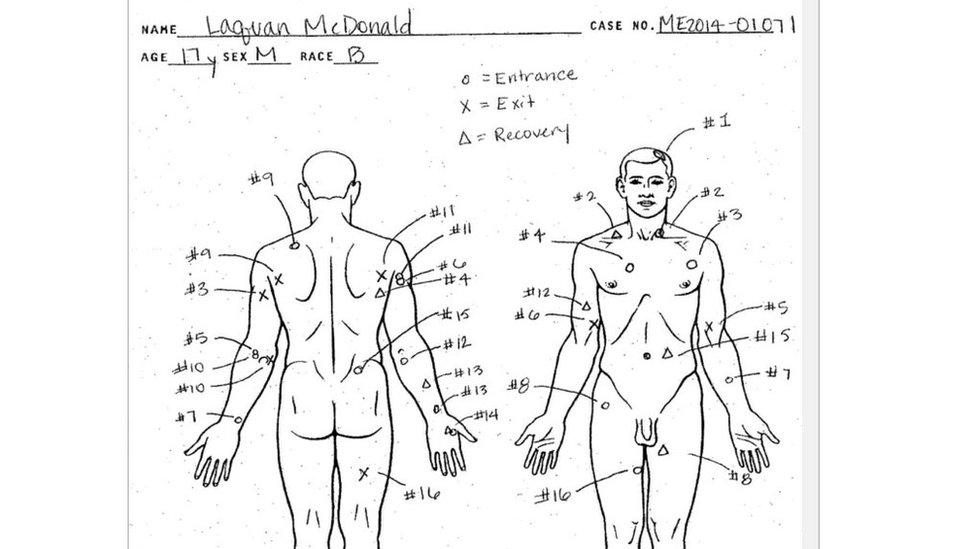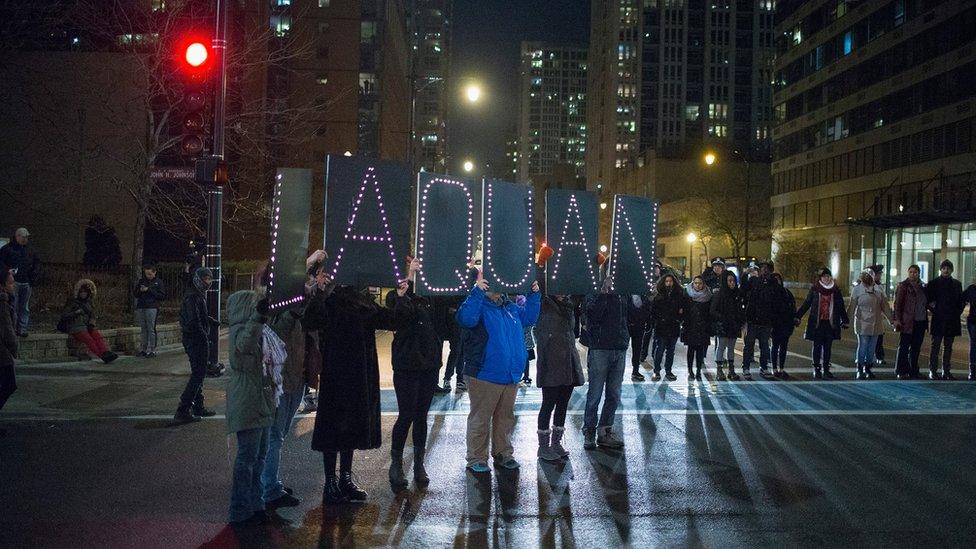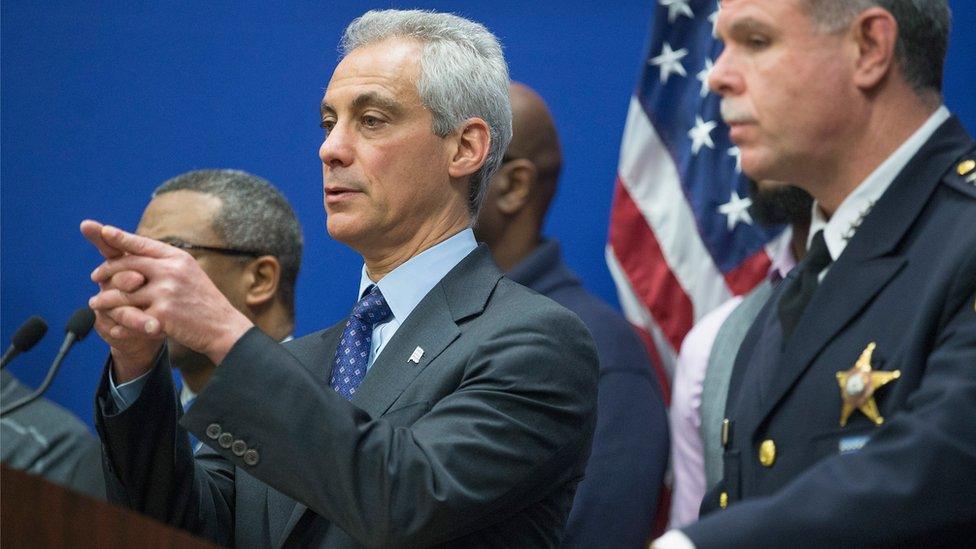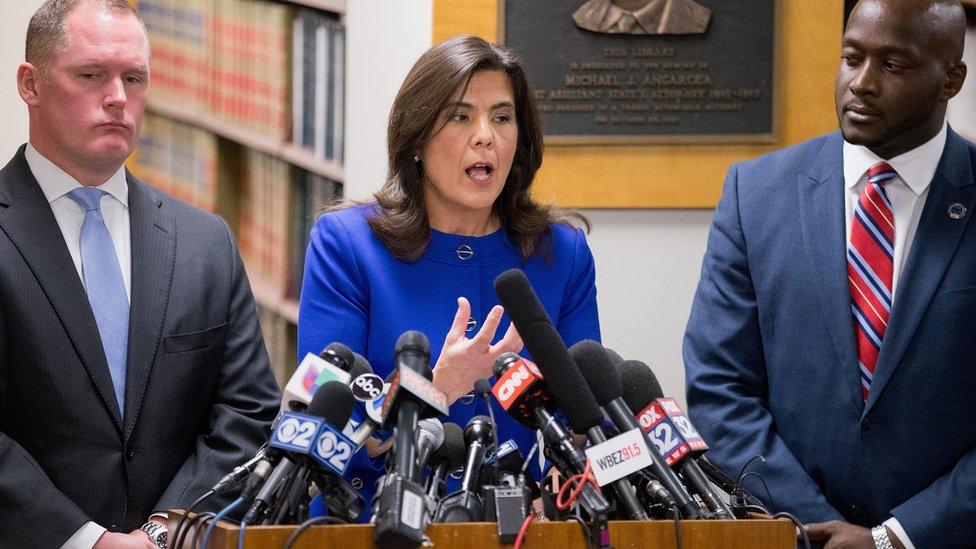How a whistleblower brought down Chicago police chief
- Published

Former Chicago police superintendent Garry McCarthy
Laquan McDonald's death seemed like another case of a justified police shooting until a whistleblower picked up the phone. One year later, the city is reeling.
On a late fall day in 2014, Craig Futterman, a professor at the University of Chicago Law School, received a phone call. He won't say who was on the other line or even where he was when he got the call.
"I want to be very careful not to give anything away that could identify them," he says now.
The mystery informant - someone "within Chicago law enforcement" according to Futterman - wanted to talk about an incident that had happened weeks earlier on 20 October, 2014, when a 17-year-old named Laquan McDonald was shot and killed by a Chicago police officer.

Laquan McDonald, right, in the dash camera footage that was eventually released
At the time a spokesman, external for the local chapter of the Fraternal Order of Police said that McDonald had punctured a police cruiser's tire with a knife, damaged its windshield, then lunged at officers before he was felled with a single shot to the chest.
"The officers are responding to somebody with a knife in a crazed condition, who stabs out tires on a vehicle and tires on a squad car," the spokesman told a local TV station, external. "He is a very serious threat to the officers, and he leaves them no choice at that point but to defend themselves."
It was a common story in Chicago. According to the Better Government Association, external, Chicago police shot 240 people over a four-year span, or about one per week.
Seventy of those people died and of those, two-thirds were African American. The city's Independent Police Review Authority has investigated 400 police shootings since 2007 and found only one incident to be unjustified.
It seemed as though McDonald's case would be chalked up as another justified use of deadly force.
But the person on the phone told Futterman a very different story. He said the shooting was captured on a police vehicle's dash camera.

A diagram from McDonald's autopsy shows where his body was struck by bullets
"They told me that it looked like an execution and they were deeply afraid it was going to be buried," recalls Futterman. "The video would be buried and nothing would happen."
Futterman soon called Jamie Kalven, founder of the Invisible Institute, external, a nonprofit journalism outfit on the south side of Chicago.
The two have worked together for years on claims of misconduct and brutality against the Chicago police department. It was that reputation that led the whistleblower to them.
"It took a lot of courage to even seek me out confidentially," says Futterman. "It's something that could put their job and their life in serious jeopardy."
Using information provided by the whistleblower and his own inquiries, Kalven was able to track down two witnesses to the shooting - a passing motorist and a truck driver who was parked nearby.
Both gave an account of the shooting that matched up with the description given by the whistleblower.
Seven weeks after McDonald's death, Kalven and Futterman released a joint statement calling for the release of the dash camera footage.

"With no apparent provocation - the boy was shying away rather than lunging toward them - a white male officer shot Laquan, who fell to the ground," they wrote, external. "After a pause, as the boy writhed on the ground, the officer fired repeatedly into his body."
"That got a flurry of attention locally," recalls Kalven. "Columnists wrote about it."
Two months after that, Kalven obtained a copy of McDonald's autopsy report. The document that called into serious question the police description of what happened.
"The most salient aspect was 16 independent gunshot wounds front and back," says Kalven. "There was no way to square that information with the official narrative."
Kalven published his findings in Slate, external. By then, many Chicagoans were following Kalven's work, including Jeff Neslund, a lawyer for the McDonald family.
As he prepared to file a lawsuit against the city on the family's behalf, Neslund subpoenaed and successfully obtained a copy of the tape, along with a cache of records from the investigation that followed.
"There were a couple ways to go here. We could hold a press conference, the circus could come to town and we could let it fly," says Neslund. "Or, call the city, see if they want to meet and settle the case."
Neslund says McDonald's mother did not want the tape released, and opted to go to the city.

Chicago mayor Rahm Emanuel answers questions on the eve of the tape's release
In April 2015 - just days after a contentious campaign season ended in the re-election of Mayor Rahm Emanuel - the city agreed to pay the family, external a $5m (£3.3m) structured settlement, which included an agreement not to release their copy of the footage.
But just because both the family and the police wanted a tape suppressed doesn't make it law. Journalists and activists were demanding the tape's release under Illinois' Freedom of Information Act, external (FOIA), which says that citizens have a right to view government records.
Brandon Smith, an independent freelance journalist, was one of more than a dozen reporters to to request the tape. But - as a local reporter who had repeatedly gone to battle with the city over its withholding of records - he was the only one to file a lawsuit against the police department after it denied the request.
"I made the request because all kinds of stuff seemed fishy," he says. "I think the city has a real transparency problem."
Dashcam footage shows the moment 17-year-old Laquan McDonald was fatally shot by police in Chicago
Three months later, on 19 November, a judge ruled, external that the Chicago police department failed to show that releasing the video would significantly impede any ongoing investigation. He ordered the tape be released within the week
The city moved quickly. The day before the 25 November deadline, the officer Jason Van Dyke was arrested and charged with first-degree murder. At a press conference, Mayor Emanuel and police superintendent Garry McCarthy emphasised that the shooting was the act of a single officer who "needs to be held accountable".
Hours later, the tape was released. It showed exactly what the whistleblower described to Futterman 13 months earlier. McDonald walks, external down the middle of the street holding a 3-inch blade in one hand. He encounters police officers, but is moving away from them when Van Dyke opens fire, shooting McDonald 16 times.

Chicago officer Jason Van Dyke is charged with murder
The release has led to protests and demands to know who in city government and in the police department tried to keep the tape from the public.
There have been allegations that other officers on the scene purposely stymied the investigation.
The New York Times called what happened a "cover-up", external and a "scandal".
In response to the demand for further accountability, Emanuel asked for McCarthy's resignation on Tuesday this week. He also introduced a new task force that will aim to improve police misconduct investigations and establish "best practices for release of videos of police-involved incidents", external.
Some Chicagoans are asking for Cook County State's Attorney Anita Alvarez to resign for not charging Van Dyke sooner.
Her office then cast blame, external on Mayor Emanuel, saying the decision to withhold the tape came from his office.
"That makes this whole episode look like an attempt by the city, the police and prosecutors to keep the video under wraps, knowing the political problems it would most likely create," writes the editorial board of The New York Times.
Both Alvarez and Emanuel have said they will not resign.

Cook County State Attorney Anita Alvarez announces charges for Jason Van Dyke
Meanwhile, Smith has filed another FOIA request. The request asks for the names of the other officers on the scene, emails about the case between the police and the mayor's office, and "all internal police department communication regarding the case", external.
Attorney Neslund says there could be additional revelations from a federal investigation by the FBI and the US Attorney's office, which is still "active and ongoing".
"We had access to a lot of things that were not made public," he says.
As the fallout continues, Kalven says he is in a "state of amazement" that the work that began with a single phone call has resulted in the firing of one of the top cops in the US. As for the whistleblower, neither Kalven nor Futterman know if his identity will ever be revealed.
"He's still in the government, I'm sure relishing these developments," says Kalven. "I hope the day will come when his role can be fully acknowledged and his story be told."
Subscribe to the BBC News Magazine's email newsletter to get articles sent to your inbox.